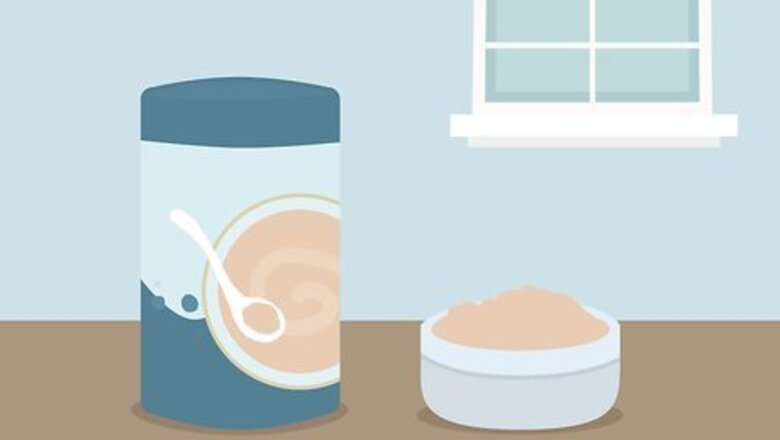
views
X
Trustworthy Source
Mayo Clinic
Educational website from one of the world's leading hospitals
Go to source
The safest way to feed your baby oatmeal mixed into Similac formula is to combine them in a bowl. If your doctor says it’s okay, you might try adding a small amount of oatmeal to your baby’s bottle if they have acid reflux. However, always check with your baby’s doctor before you provide them oatmeal.
- Pour 4 to 5 tablespoons (59 to 74 mL) of liquid Similac formula in a bowl.
- Stir 1 to 2 tablespoons (15 to 30 g) of powdered baby oatmeal into the formula.
- Start with 1 serving of oatmeal a day and gradually increase as your baby adjusts.
Making a Bowl of Oatmeal
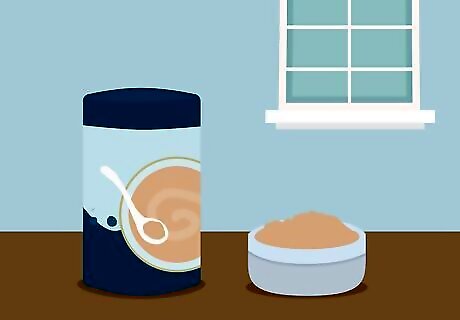
Use baby oatmeal that’s ground to a fine powder. Always give your baby foods that are packaged for babies, especially when your they first start eating solid foods. Look for baby oatmeal in the baby section of your local grocery store or online. It’s ground into a powder to help reduce the risk of choking.Variation: Use a food processor or spice grinder to grind rolled oats into a fine powder if you want to make your own oatmeal. Make sure that it’s free of clumps before you use it for your baby.

Prepare 4 to 5 tablespoons (59 to 74 mL) of Similac formula in a bowl. Use a measuring spoon or cup to measure out your baby’s formula. Then, follow the instructions on the package to mix in water, if necessary. Stir to combine the ingredients until they’re consistent. Some Similac formulas are ready-to-eat and don’t require water. However, you will need to add water to a powdered or concentrated formula. Make sure you follow all of the directions exactly. Try to use as little formula as possible—you still want the puree to hold its shape on a spoon. That way, your baby can practice their eating skills, rather than just drinking the mixture.

Add 1 to 2 tablespoon (29.6 ml) (10 to 20 g) of baby oatmeal to the bowl. Measure out the oatmeal and add it to the bowl. Then, use a spoon to stir the oatmeal into the formula until the ingredients are mixed. The oatmeal should be very runny because it will be easier for the baby to swallow. Mix up the oatmeal right before the feeding. Don’t let the oatmeal sit out before the feeding because it will gradually thicken. If it’s too thick, it can become a choking hazard.Tip: You don’t need to heat up the oatmeal. Serving it cold will help you avoid burning your baby’s mouth.

Sit your baby upright in a chair or your lap. Sitting upright helps your baby swallow the oatmeal without choking. Secure your baby in a highchair or hold them in your lap. Make sure your baby stays sitting up for their entire meal so they don’t choke. Your baby’s ability to swallow is still developing, so it’s easier for them to choke. Keeping them upright reduces the risk of choking.

Use a small spoon to feed your baby the thickened formula. It’s always best to use a spoon that’s made for babies. Unfortunately, spoons made for adults can hurt your baby’s mouth. Look for a spoon that’s small and that doesn’t have sharp edges. Some baby spoons have a rubber coating that makes them safer to use.
Thickening Formula in a Bottle

Use caution when feeding oatmeal in a bottle. Generally, it’s best to feed oatmeal from a bowl. However, your doctor might approve adding oatmeal to your baby’s bottle if they have acid reflux. Check with your doctor before using the oatmeal to thicken your baby’s formula. If you’re adding oatmeal to a bottle, the mixture should primarily contain formula. If it’s too thick, it will be hard for your baby to drink.

Purchase baby oatmeal that’s ground to a powder. Your baby can’t swallow thick foods yet, so only feed them products prepared for babies. Get baby oatmeal from the baby section of your local department store or online.Variation: Make your own baby oatmeal by grinding rolled oats into a fine powder. Make sure the powder is free of lumps before you serve it to your baby.

Follow the instructions on the packaging to prepare the Similac formula. Pick the Similac formula that your doctor recommends or that your baby is able to tolerate the best. Then, use the directions on the label to prepare it. Depending on the type of formula you’re using, do one of the following: Mix water into powdered Similac formula. Dilute concentrated liquid Similac formula with water. Pour ready-to-feed Similac formula directly into the bottle.
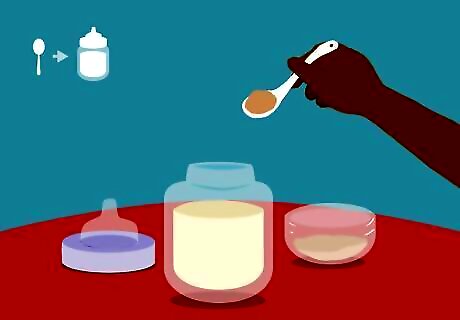
Add 1 tsp (2 g) of oatmeal to your baby’s Similac formula. Use a measuring spoon to add oatmeal to your baby’s bottle. Use 1 tsp at first to see how your baby tolerates it, or follow your doctor’s instructions. You might add more oatmeal if your doctor says it’s okay. The maximum amount of oatmeal that you can add to a bottle is 1 tsp (2 g) of oatmeal per 1 tablespoon (15 mL) of formula.
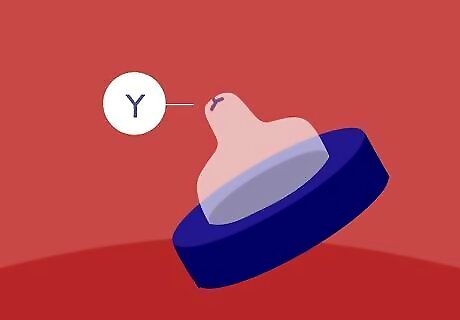
Use a “Y” shape or crosscut nipple so the thickened formula can pass through it. The oatmeal will thicken the formula, so your baby needs a wider nipple hole to drink it. Fortunately, you can purchase “Y” shape or crosscut nipples. Attach this type of nipple to your baby’s bottle when you feed them the thickened formula. You can purchase these nipples near the bottles at a baby store or online. Alternatively, make your own nipple by cutting across the hole. Keep the hole small because a big hole can cause choking. Be sure to wash the nipple thoroughly before you use it.
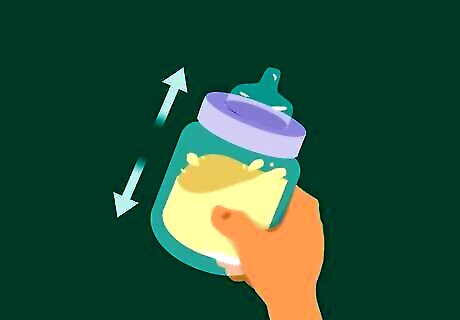
Shake the bottle to mix the oatmeal into the formula. Use your arm to shake the bottle and combine the ingredients. Give the bottle several big shakes to mix the oatmeal into the formula. You don’t need to heat up the bottle. However, it’s okay to submerge it into hot water to warm up the thickened formula if your baby prefers it.

Watch your baby closely as you feed them the formula. Hold your baby while you feed them the thickened formula. Pay careful attention to your baby to make sure that they don’t choke. Unfortunately, choking is a hazard when you’re feeding your baby thickened formula.
Giving Your Baby Oatmeal Safely

Talk to your baby’s doctor before you feed your baby oatmeal. Although oatmeal is considered healthy for your baby, it’s best to avoid feeding it to your baby before they’re 4 months old. Additionally, always check with your doctor before you start feeding your baby any solid foods, even if it’s just a small amount. Follow your doctor’s advice. Dealing with reflux in babies can be stressful, so you probably want to try anything that might help. However, oatmeal might make it worse. Your doctor can help you figure out what will work best for your baby.

Be careful that you don’t overfeed your baby. Oatmeal contains calories, so adding it to your baby’s formula increases their calories. Talk to your baby’s doctor to find out if you need to adjust how much you’re feeding them. Otherwise, they might gain weight. Feeding your baby solid foods too soon increases their risk of obesity, so be careful. Your doctor can help you decide if overfeeding is a concern for your baby. If your baby has struggled to keep food down, you may not need to worry about this.

Avoid adding honey to your baby’s oatmeal because it can cause infant botulism. Honey cannot be given to babies under the age of 12 months. There is bacteria in honey that can contaminate the food. Never give honey to your baby. After your baby turns 1, check with your doctor to find out when it’s safe to introduce honey.
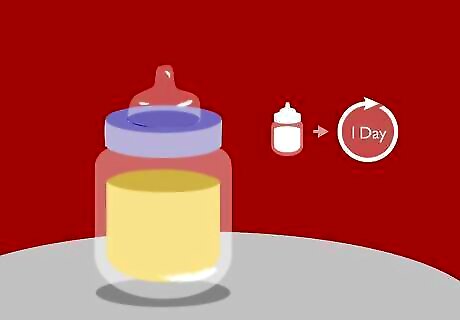
Start your baby with 1 serving of oatmeal a day. It will take time for your baby to get used to eating solid foods, so don’t replace their regular feedings with oatmeal right away. Give your baby time to adjust to oatmeal by only offering it once a day. If your baby responds well to the oatmeal and your doctor says it’s okay, you might try adding baby oatmeal to more meals.

Be patient if your baby gets fussy or refuses the oatmeal mixture. Your baby may need time to adjust to the taste and texture of oatmeal. However, adding it to their formula may help your baby get used to the oatmeal faster. Offer oatmeal to your baby, but don’t try to force them to eat. Keep offering oatmeal to your baby at feedings until they start to willingly eat it. When your baby is ready, they’ll be interested in trying solid foods, including oatmeal.

















Comments
0 comment